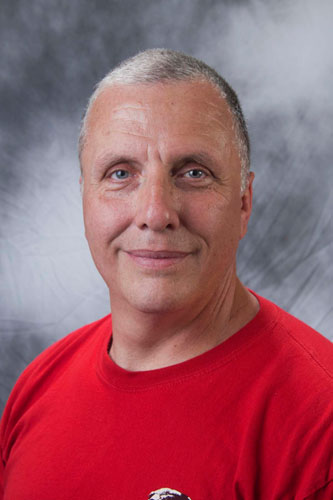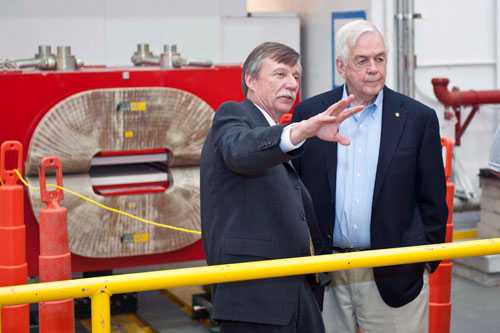
Mouse Medicine: System Gets Clear, 3D Brain Scans of Moving Mice |
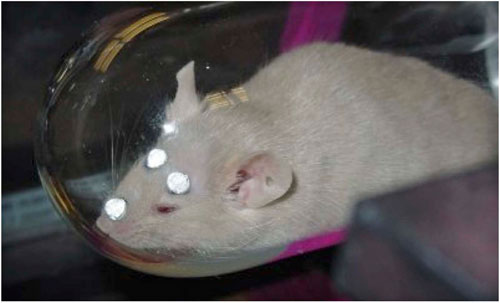 Three markers attached to the head of a mouse enable the AwakeSPECT system to obtain detailed, functional images of the brain of a conscious mouse as it moves.
Setting a mouse free to roam might alarm most people, but not researchers who have developed a new imaging system for mouse brain studies. The new system can be used to aid preclinical research for earlier diagnosis and better treatments for a host of brain diseases, including Alzheimer's disease, dementia, Parkinson's disease, brain cancers and drug addiction. Scientists use dynamic imaging of mice to develop better ways to diagnose disease and formulate better treatments. The imaging studies allow researchers to follow changes in brain chemistry caused by the progression of disease or the application of a drug. In these studies, laboratory mice are typically drugged or bound in place so that their brains can be studied. However, subjecting the mice to chemical or physical restraints can taint the results of such research. "Part of the problem with imaging animals, particularly mice, is that you need to anesthetize or restrain physically the animal to make it be motionless while you acquire the imaging. It's not a problem typically with clinical applications, because you can ask the (human) patient to remain still," says Drew Weisenberger, who...... more |
|
|
Experimental Check Yields Surprising New Result
|
JSA Announces Outstanding Nuclear Physicist Recipients for 2013
|
2013 JSA Postdoctoral Research Grant Winner to Compute Quarks
|
||
|
|
||||
Below the Fold:
|
||||
|
|
||||
Mouse Medicine: System Gets Clear, 3D Brain Scans of Moving Mice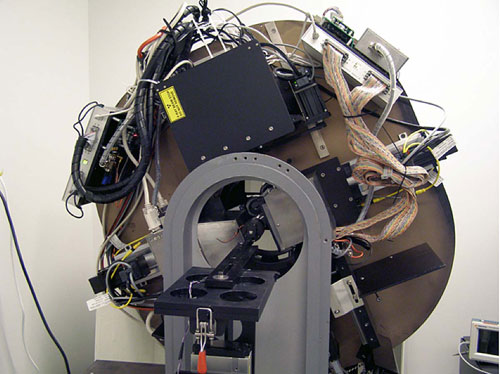 Pictured is the imaging acquisition portion of the AwakeSPECT system. The AwakeSPECT uses two Jefferson Lab custom-built gamma cameras.
Setting a mouse free to roam might alarm most people, but not researchers who have developed a new imaging system for mouse brain studies. The new system can be used to aid preclinical research for earlier diagnosis and better treatments for a host of brain diseases, including Alzheimer's disease, dementia, Parkinson's disease, brain cancers and drug addiction. Scientists use dynamic imaging of mice to develop better ways to diagnose disease and formulate better treatments. The imaging studies allow researchers to follow changes in brain chemistry caused by the progression of disease or the application of a drug. In these studies, laboratory mice are typically drugged or bound in place so that their brains can be studied. However, subjecting the mice to chemical or physical restraints can taint the results of such research. "Part of the problem with imaging animals, particularly mice, is that you need to anesthetize or restrain physically the animal to make it be motionless while you acquire the imaging. It's not a problem typically with clinical applications, because you can ask the (human) patient to remain still," says Drew Weisenberger, who heads the Jefferson Lab Radiation Detector and Imaging group. Weisenberger led the multi-institution effort to develop a nuclear imaging system that could clearly scan a mouse's brain in the comfort of a burrow, without the need for restraints, known as the AwakeSPECT system. "The AwakeSPECT system does regular SPECT imaging of mice. SPECT is a nuclear medicine imaging technique that's used in humans for various types of diagnostic studies. It's also used in animal studies to facilitate the development and understanding of disease physiology," Weisenberger says. SPECT is Single-Photon Emission Computed Tomography. In this technique, a radionuclide is injected, where it collects in specific areas of the brain by function. The radionuclide emits gamma rays (single photons) that are collected by a detector in separate scans from many different angles. The scans are combined in an algorithm to produce a three-dimensional image. Researchers from Jefferson Lab, Oak Ridge National Laboratory, Johns Hopkins Medical School and the University of Maryland all contributed to the development and implementation of the system. Weisenberger says the AwakeSPECT system uses two Jefferson Lab custom-built gamma cameras to image the radionuclide, as well as a system that processes the data to produce the three-dimensional images. Two patents were awarded to Jefferson Science Associates, LLC, for the innovative technology associated with this system: "Anatomic and functional imaging of tagged molecules in animals," and "Method for image reconstruction of moving radionuclide source distribution." Additionally, an infrared camera system developed at Oak Ridge tracks movement of the mouse. Finally, a commercially available CT system provides additional anatomical information. The beauty of the AwakeSPECT system is that it doesn't require that the mouse (or potentially people, at a later stage) remain motionless. "We developed this system that, while acquiring SPECT images, uses infrared cameras that track the location and pose of the head. We use that information to then computationally remove motion artifacts from our SPECT imaging," Weisenberger explains. Researchers at Johns Hopkins, led by Martin Pomper, conducted the first mouse imaging studies with the new system. To prepare a mouse for imaging with AwakeSPECT, it is first tagged with three markers that are glued to its head for the infrared system to track. Once the radionuclide is injected, the mouse can then be imaged as it rests in a homey, burrow-like, clear tube. "After we've done the imaging, the mouse goes back in his cage. After a while, the little markers fall off. And then we analyze the data offline," Weisenberger adds. In this recent study published online in The Journal of Nuclear Medicine, the researchers showed that the AwakeSPECT system can obtain detailed, functional images of the brain of a conscious mouse as the mouse moves around freely in an enclosure. The AwakeSPECT system then was used to document for the first time the effects of anesthesia on the action of a dopamine transporter imaging compound, 123I-ioflupane, in the brains of awake and anesthetized mice. Such dopamine transporter imaging compounds are used for Alzheimer's, dementia and Parkinson's disease studies. The researchers found that the drug was absorbed less than half as well in awake mice, showing that the use of anesthetic could potentially confound drug uptake studies. "It was not surprising, but it had never been measured before; it had never been confirmed that mice do react that way to anesthesia with a compound. It would be interesting to do the same thing again with a different anesthesia. We might find that there's an anesthesia that doesn't cause any issues," he says. Weisenberger says the next step is to improve the AwakeSPECT imager by upgrading the infrared tracking system, using newer technology for the SPECT imager, and by making the system more intuitive for animal researchers to operate. "We've shown the technology works. Now, you just have to make it a tool that more people will readily use." he adds. Early funding for the program was provided by DOE's Office of Science, and more recent support has been provided by the National Institutes of Health. By Kandice Carter |
||||
|
|
||||
Experimental Check Yields Surprising New Result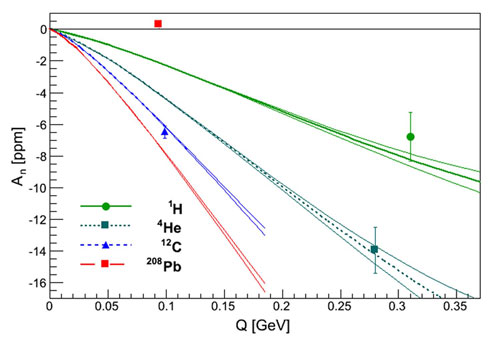 The asymmetry An for four nuclei compared to model expectations. Notice that An is supposed to be the largest for 208Pb, but the data are consistent with An = 0
A routine experimental check has revealed that energetic electrons may interact more profusely with nuclei that contain more protons than those with fewer. Though not completely unexpected, the researchers were surprised to find evidence of the effect in this experimental check. The result comes from explorations of the lead nucleus, and it could provide insight into heavy matter. The scientists got the result from experiments that consisted of banging spinning electrons into various nuclei and observing the aftermath. According to Robert Michaels, a Jefferson Lab nuclear physicist in Experimental Hall A, the spin of these electrons must be precisely aligned in the preferred direction for the measurements to be successful. That's because the scientists are getting their information from the tiny differences, called asymmetries, that the experiments give them when they flip the spin of the electrons from one direction to its opposite and compare the results. If the spin of the electrons are not precisely aligned along the direction of interest, then these asymmetries are not entirely due to the phenomenon that is being measured. For the HAPPEx and PREX experiments, the scientists were measuring the asymmetries for electrons that spin along the direction of travel of the electrons and opposite the direction of travel. (This asymmetry measurement provides a direct probe of the weak interaction.) "We were worried that the beam had its spins slightly tilted. When you flip the spin you get an asymmetry which might be large and have nothing to do with the weak-interaction effect that we were trying to isolate," Michaels says. If the spin direction of the electrons is tilted in the up/down direction, then the asymmetry that the scientists measure could be polluted with another effect. An asymmetry between the up/down spin directions measures an effect called two-photon exchange. When experimenters probe nuclei with electrons, the electrons most often interact with protons in the nuclei by exchanging a discrete parcel of energy that physicists call a virtual photon. However, sometimes the electrons may exchange two discrete parcels of energy, or two virtual photons. With so much of the experiment's viability resting on this one detail, the scientists have developed safeguards. They measure the along/opposite asymmetries that they are primarily interested in, as well as the up/down asymmetries as a check to make sure they can correct for any tilt of the beam. Interestingly, their measurements of the up/down asymmetries yielded a surprising result. The scientists probed a variety of nuclei, including hydrogen and helium for the HAPPEx experiment and carbon and lead for the PREX experiment. Of these, most have very few protons in their nucleus, such as hydrogen (one proton), helium (two protons) and carbon (six protons). These are called light nuclei. The last nucleus, lead, contains 82 protons, and it is considered to be a heavy nucleus. "There's a theory to predict what you should see. And the theory worked well for the hydrogen, the helium and the carbon. So for the relatively light nuclei, it worked out," Michaels says. The scientists found that in the light nuclei, they measured an increasing up/down asymmetry with an increasing number of protons in the nucleus. For instance, carbon had the highest number of two-photon exchanges, the helium had fewer and hydrogen had the fewest. But the result that the researchers got for the heaviest nucleus they measured, lead, was a complete surprise. In lead, the up/down asymmetry turned out to be zero. Simplistically speaking, this indicated that there were no two-photon exchanges taking place. The scientists suspect what really happened is that their measurement of two-photon exchange may have been overwhelmed by a different phenomenon. "Now, we suspect some reasons as to why it may happen, and there is probably some reasonable explanation, having to do with Coulomb distortions, but nobody's calculated it yet," Michaels says. According to Charles Horowitz, a theorist at Indiana University, the culprit for the different lead measurement may be due to the abundance of protons in the lead nucleus. "In a lighter nucleus like carbon with only six protons, the electron only scatters with a few protons, and the probability to scatter more is very small. But with lead, since there are all these protons in the nucleus, the probability to scatter from lots of protons is big, and that apparently is giving you this very different result," Horowitz explains. It's thought that because lead contains so many protons, the electrons may have interacted with not one, but many of the protons as they traveled through the nucleus. Since the electron is far more likely to interact with a proton by exchanging a single photon, these many single-photon interactions may be overwhelming the small number of two-photon interactions. Michaels and Horowitz say that this phenomenon of multiple interactions has not yet been calculated and added to the theory used to describe such experiments. "The next step is to work on those calculations, but it's also to measure this scattering from nuclei with charges in between carbon and lead – so, a nucleus such as calcium with 20 protons, which is in between the six in carbon and the 82 in lead," Horowitz says. It's hoped that the addition of the theory calculations, as well as future experiments at other facilities, such as Mainz, may help to disentangle the result. By Kandice Carter |
||||
|
|
||||
JSA Announces Outstanding Nuclear Physicist Recipients for 2013Jefferson Science Associates has announced the recipients of the 2013 JSA Outstanding Nuclear Physicist Award: Douglas Beck, University of Illinois, Urbana-Champaign, and Paul Souder, Syracuse University. They are being recognized for their leadership in the development of the use of parity-violating electron scattering as a tool for the study of the nucleon and nuclear structure, and precision studies of the standard model. “This award to Doug Beck and Paul Souder recognizes two outstanding nuclear physicists for leading distinctive and incisive physics programs at Jefferson Lab. Both Doug and Paul have also been enormously supportive of the entire Jefferson Lab enterprise. It should also be noted that there is an implicit tribute to the builders of the accelerator which has the special properties required by these particularly demanding experiments,” said JSA President and Jefferson Lab Director, Hugh Montgomery. Beck, a physics professor at the Loomis Laboratory of Physics, University of Illinois at Urbana-Champaign since 1989, was the spokesperson for a collaboration of more than 100 researchers for the G-Zero electron scattering parity-violation experiment at Jefferson Lab, which required the development of a new spectrometer. Beck oversaw the development of the spectrometer from conception, to design and commissioning at UIUC, to installation at the lab. Among many other accomplishments and awards, he is the chair of the Brookhaven National Lab Nuclear and Particle Physics Advisory Committee and a current member of the American Physical Society Division of Nuclear Physics Executive Committee. Souder, a physics professor at Syracuse University since 1983, was instrumental in establishing a program studying parity-violating electron scattering through the HAPPEx experiments, using Jefferson Lab’s unique capabilities to explore the role that strange quarks play in the elastic form factors of the nucleon. Souder’s vision for the program, his intellectual leadership and the implementation of pioneering techniques have helped to train a new generation of capable experimentalists in a new subfield. He is an American Physical Society Fellow and Honorary Woodrow Wilson Fellow. The JSA Outstanding Nuclear Physicist Award, established in 2011 and awarded biennially, recognizes individuals who have made outstanding and sustained contributions in experimental and/or theoretical research related to the nuclear physics program at Jefferson Lab. The award is funded through the JSA Initiatives Fund Program and managed by the JSA Programs Committee. The Users Group is comprised of scientists from the U.S. and abroad who use Jefferson Lab’s facilities to conduct experiments. More than 1,230 scientists representing 29 countries and 120 institutions are members of the Users Group. The panel charged with making the selection for this year’s award was chaired by June Mathews, Massachusetts Institute of Technology, and included David Ernst, Vanderbilt University; John Hardy, Texas A&M; Robert McKeown, deputy director for Science and Technology, Jefferson Lab; Witold Nazarecwicz, University of Tennessee/Oak Ridge National Lab, and; Elizabeth Lawson, SURA chief governance officer and principal JSA/JLab liaison. The complete JSA news release is online at: http://www.jsallc.org/news/JSAONP041913.pdf |
||||
|
|
||||
2013 JSA Postdoctoral Research Grant Winner to Compute Quarks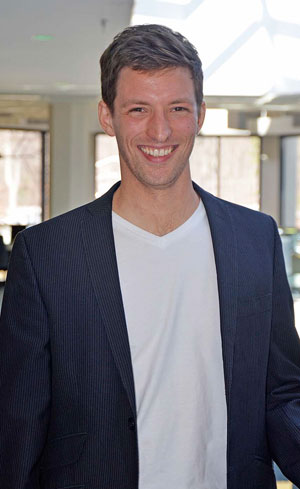 Chris Monahan, a postdoctoral research associate at The College of William & Mary, is the recipient of the 2013 Jefferson Science Associates Postdoctoral Research Grant at Jefferson Lab. Monahan's research will use a new approach for calculating how the smallest bits of matter come together to build the ubiquitous proton.
Scientists have long puzzled over how the smallest bits of matter add up to the world around us. Now, Chris Monahan will use the power of a video gaming system to attempt a new method of exploring those bits. Monahan is the recipient of the 2013 Jefferson Science Associates Postdoctoral Research Grant at Jefferson Lab, which will provide $11,000 for his research. He was selected for the grant by the Users Group Board of Directors, the governing body of the group that represents scientists who use Jefferson Lab facilities to conduct nuclear physics research. "Once again, we received some very strong proposals. The board felt that all of the proposals featured worthy projects," says Sebastian Kuhn, board chairman and a professor of physics and eminent scholar at Old Dominion University. "We chose Chris Monahan's, because it most clearly showed where the research grant would make a difference. Board members also felt that his proposal did a very good job describing exactly what he is planning to do, and he had very strong letters of support." Monahan's research will use a new approach for calculating how the smallest bits of matter, quarks and gluons, come together to build the ubiquitous proton. "This project is aimed at developing a new way of comparing numerical data from a computer to experimental data. There are a number of ways of doing this, but none of them are ideal. This won't be ideal, but it takes advantage of some new developments," Monahan explains. The method uses lattice QCD, an approach that harnesses the power of supercomputers to solve the theory that describes how quarks and gluons build protons, neutrons and other particles in the heart of matter. Lattice QCD helps simplify the problem by breaking up space and time into a grid system that a computer can use to calculate numerically the behavior of quarks and gluons. "I like to picture it like a chessboard. You can imagine that the quarks could really live anywhere on the chessboard. But a computer can't deal with so many possibilities. So instead, you say they can only appear on the black squares. That way, you've only got a finite number of possibilities to deal with," he says. To increase the accuracy of the computations, the scientists need to make the squares smaller. However, the problem with this method is that the smaller you make the squares, the longer it takes for the computer to run the calculation. Monahan's method may get around that issue. He plans to use the power of a graphics processing unit, the same type of processor that powers gaming systems, to compute the problem differently. "Instead of making the black squares smaller, you could make the quarks bigger. And then the black squares look smaller to the quarks, comparatively," he explains. If the new approach works, Monahan says the method could require less computing power to perform these difficult calculations, saving time and money while also benefiting physicists who compare such calculations to the results they get from experiments probing quarks and gluons. "Given the great importance of lattice QCD calculations to interpret the future 12 GeV program at the lab, the proposed research is clearly of relevance for the core Jefferson Lab physics program," Kuhn notes. Monahan will use about a third of the grant to assemble a computer for testing the new method, another third to fund a new graduate student over the summer to assist with the programming and the last third to attend an international conference of lattice QCD physicists in hopes of presenting his first results. "Chris Monahan's lattice QCD work is particularly promising, and we are looking forward to his results and potential positive impact on Jefferson Lab research," says Hugh Montgomery, JSA president and Jefferson Lab director. "It is our youth who will make the scientific discoveries and the technological developments of the future. This grant continues our commitment to providing the next generation of scientists with challenging and rewarding research opportunities." Monahan completed his undergraduate degree in physics (M.Phys.) at the University of Edinburgh and his Ph.D. at the University of Cambridge. He is currently a postdoctoral research associate at The College of William & Mary. The JSA Postdoctoral Research Grant has been awarded annually since 2008 by the Users Group Board of Directors. In making the award, the board judges each applicant on his or her record of accomplishment in physics, proposed use of the research grant and the likelihood of further accomplishments in Jefferson Lab research fields. The research grant is one of the funded projects of the JSA Initiatives Fund program, provided by Jefferson Science Associates to support programs, initiatives, and activities that further the scientific outreach, and promote the science, education and technology missions of Jefferson Lab and benefit the lab’s user community. Kandice Carter |
||||
|
|
||||
Below the Fold: |
||||
Machining & Fabrication Company Earns JLab’s Small Business Award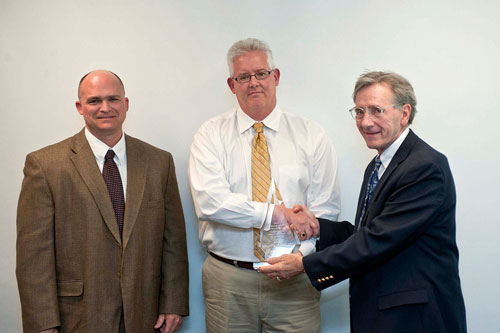 Astro Machine Works, Inc., a machining and fabrication company from Pennsylvania, has been awarded the Jefferson Science Associates 2012 Outstanding Small Business Subcontractor Award. Astro President Eric Blow (center) and Randy Miller, Astro’s government sales representative, accept the award from Mike Dallas, Jefferson Lab’s chief operating officer.
Jefferson Science Associates, the operations and management contractor for Jefferson Lab, has awarded its 2012 Outstanding Small Business Subcontractor Award to a machining and fabrication company from Pennsylvania. The Ephrata, Pa., business was selected for the competitive award by Jefferson Lab’s small business advocacy team. The company was selected from the dozens of small businesses that provided services or products to the lab during fiscal year 2012. The initial list was shortened to the top 24 subcontractors, then to the top four contenders, according to Danny Lloyd, Jefferson Lab’s Small Business Program manager. The purpose of the award program is to recognize and reward the top performing small firms doing business with Jefferson Lab, according to Lloyd. Any small business, including women-owned, veteran-owned, service-disabled veteran, HUBZone, or disadvantaged business doing work for Jefferson Lab may be considered for the award. This marked the 22nd year that the lab has presented the award. Senior Jefferson Lab and Department of Energy managers met with Astro Machine Works President Eric Blow and government sales representative, Randy Miller, on April 25 at the lab, to present the award. Astro was chosen for the award because of its outstanding work, attention to detail and quality control on components fabricated for the lab, its timeliness and reliable pricing, according to Lloyd. “Everyone at Jefferson Lab who interacts with the Astro team has been impressed,” Lloyd said. “Astro consistently meets the exacting specifications we require. Our customer surveys give them high marks. Even our Shipping and Receiving group has commented on the great job they do packing the finished components for shipping and the excellent condition of the items when they arrive at the lab. Astro is top notch.” During fiscal year 2012, Astro received 26 Jefferson Lab work orders totaling $673,000. The firm has been competing for lab fabrication and machining work since 2009 – through FebBid.com – a web-based marketplace for business-to-government e-commerce. Representing the DOE, Wayne Skinner, Thomas Jefferson Site Office contracting officer, said, “You have been and continue to do an excellent job supporting Jefferson Lab by fabricating key components for the laboratory and the lab’s 12 GeV Upgrade project. No one views Astro Machine Works as a small business contractor but as a contractor that performs in an outstanding manner and supports its customers’ needs. Thank you for your part in making Jefferson Lab and this project a success. The lab and the DOE rely greatly on the capabilities of our small business subcontractors to meet the Department’s needs.” Skinner also commended JSA for its strong commitment to the DOE’s Small Business Program and for establishing a Small Business Recognition Program. Mike Dallas, Jefferson Lab’s chief operating officer, also thanked Blow and Miller for the service Astro has provided and congratulated them on winning this year’s award. “We take seriously our responsibility to promote and use small business, and we thank you for your key role in making the lab a success. You are part of a very important project at the lab and we appreciate the great work you are doing.” In accepting the award, Blow said, “We are a very blessed company. Thank you very much for this recognition; we are extremely humbled. …We have a very team-centered culture. In a perfect world, I’d have 74 other people with me today to accept this recognition. I can’t say enough for our Astro staff.” Lab Earns DOE Sustainability Awards for Green Procurement Efforts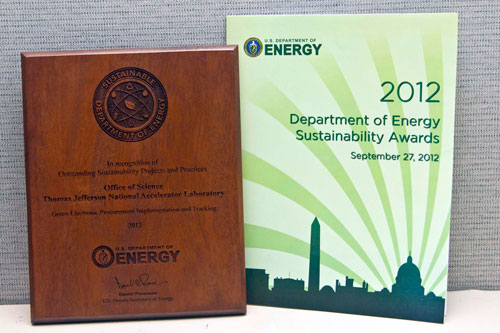 Jefferson Lab received a 2012 Sustainability Award from the Department of Energy for its Green Electronic Procurement Implementation and Tracking program. The award was one of 21 team and individual awards presented at the second annual DOE Sustainability Awards event
Jefferson Lab has received a 2012 Sustainability Award from the Department of Energy for its Green Electronic Procurement Implementation and Tracking program. In notifying lab management of the award, Director of the DOE Sustainability Performance Office, Jennifer MacDonald, wrote, "…This project exemplifies the innovation and commitment to sustainability the awards program is designed to recognize. …Congratulations on your outstanding achievements!" The award to a team from Jefferson Lab was one of 21 team and individual awards presented at the second annual DOE Sustainability Awards ceremony held at DOE Headquarters in Washington, D.C. The awards recognize outstanding sustainability accomplishments ranging from managing pollution, waste, energy, water and vehicle fleets. Prior to the ceremony, DOE hosted a Sustainability Best Practices Workshop, featuring presentations from many of the award recipients on their winning projects. Jefferson Lab staff members Kari Heffner and Andy Kowalski, Information Technology Division, and Danny Lloyd and Dena Polyhronakis, Procurement staff, were instrumental in developing and implementing Jefferson Lab’s program. Continuous improvement is a goal and ongoing effort within the lab's Sustainability program, according to Bill Rainey, Environmental, Health and Safety manager. “Receiving this award is the result of one of these sustainability efforts,” he points out. A few years ago Jefferson Lab adopted the Electronic Product Environmental Assessment Tool, dubbed EPEAT, for purchasing computer and computer–related equipment. EPEAT is a comprehensive environmental rating system used globally to identify greener computers and other electronic equipment, according to Rainey. EPEAT products provide positive environmental impacts including reduced greenhouse gas emissions, reduced energy use, generation of less hazardous and nonhazardous wastes, and significantly less use of the toxic metal mercury. Computer Center staff, within the IT Division, then began developing and implementing an approved configuration referred to as the "bundle program," which identified computer systems approved for use at Jefferson Lab. EPEAT compliant desktop, laptop, workstation and monitor "bundles" were identified for three levels of Jefferson Lab computer users: administrative, technical, and scientist – to address the varying computer needs of staff throughout the lab, Rainey explained. All orders were made through JLab's electronic procurement system, and computer-related procurements were automatically relayed to the Computer Center for review and approval. 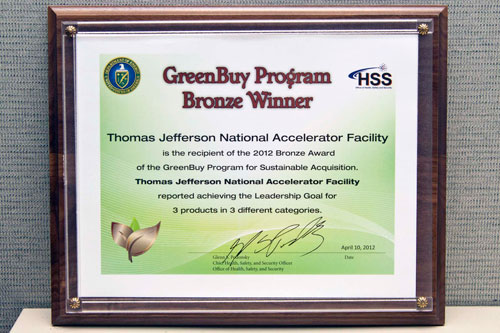 In conjunction with presenting the 2012 Sustainability Awards, the Department of Energy also presented its GreenBuy Program awards. Jefferson Lab received a 2012 Bonze GreenBuy Award for excellence in sustainable acquisition. The lab achieved the leadership goal for at least three products in three different categories. The program is managed by the Office of Sustainability Support within the DOE Office of Health, Safety and Security
In 2011, further refinements were made to the configuration and ordering system. Computer code developed by Computer Center staff enabled generating a report for EPEAT-related purchases, making it simpler and easier for the Procurement department to track the number of EPEAT bronze, silver and gold purchases (with gold being the most environmentally friendly) for the Pollution Prevention and Reporting Database. The database also facilitates the tracking of trends. For example, EPEAT gold purchases increased in 2009, 2010, and 2011 for monitors, desktop computers and laptops. "The trend is clearly going the way we envisioned," Rainey noted. "For example, purchases of EPEAT gold computer monitors at the lab went from 31 percent in 2009 to 95 percent in 2011. This is a significant improvement for the lab." The bundling system has provided enhanced efficiency for the Computer Center in several areas. EPEAT gold-rated systems now dominate purchases; and because bundling limits the variety of computers, the Computer Center can now more effectively manage software installations and upgrades, which reduces the vulnerability of introducing destructive code into the lab's network-based systems. And ordering time and manpower have been reduced as the process went from a multi-step time intensive effort, to an automated system with a small inventory buffer. In addition, the program has reduced costs and waste. By standardizing computer suites, Jefferson Lab has reduced the number and types of repair parts needed, the volume of required documentation, and the types of training needed, according to Kowalski, Computing and Networking Infrastructure manager. Tighter configuration control means computer system users are much less likely to end up with a computer that does not meet their needs and gets shelved or excessed, he added. And, EPEAT products are shipped in packaging that produce less waste than non-EPEAT products. Ready, Set, Go! to the May 22, 2013 Run-A-Round Check your running shoes and save the date! The 28th annual Jefferson Lab Run-A-Round event will be held Wednesday, May 22, from 3 - 6 p.m. JLab staff, users, students, full-time contractors and immediate family members are invited to participate. Staff and users that participate in the run or that volunteer can receive a free 2013 JLab T-shirt. The event will begin in front of CEBAF Center at 3 p.m. with the debut of the 2013 T-shirt. The run/walk will start promptly at 3:15 p.m.; please note this start time differs from years past. The run will cover a 2.2 kilometer (~1.36 mile) course. Food and beverages, music and the awards presentations will follow the race. Awards will go to the top three male and female finishers in each age group and to the top three overall fastest male and female finishers. Included this year is a special category dubbed the "Stroller Stride." Bring the littlest ones and compete with the exclusive stroller group, encourages Bridget Paul, Jefferson Lab Activities Group chair. Register For Run-A-Round By May 21 Help Make Event a Success: Volunteer One Hour of Your Time Volunteer help is needed before, during and after the event in a variety of areas, including: Education Seeks Projects for Summer Honors Interns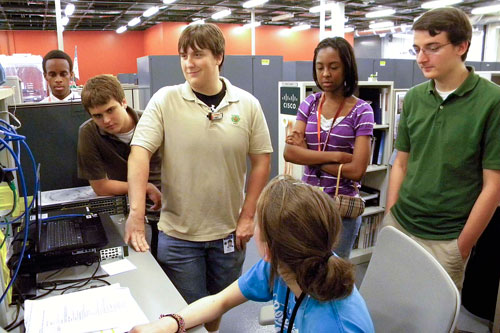 Pictured are student participants from the 2012 High School Summer Honors Program at Jefferson Lab. Science Education staff is currently seeking lab scientists, engineers or technical managers who are interested in serving as a mentor to a student and have a project that a student could accomplish this summer.
Seven high school students have been selected to participate in Jefferson Lab's 2013 High School Summer Honors Program, which will be held at the lab June 24-Aug. 2. The students are currently high school juniors and seniors and have expressed interest in pursuing scientific and technical careers. Lab scientists, engineers and other technical managers who are interested in serving as a mentor to a student or students and have a project, or number of projects, to be accomplished this summer, are asked to send a description of the work or any questions you may have about the program to Brita Hampton, Science Education, as soon as possible. The students will be required to develop a poster about their project and present it during a poster session at the end of the program. Milestones for MarchHello Goodbye These Milestone entries, listed alphabetically, are full-time, term, casual and student actions posted by Human Resources for March 2013. Jefferson Lab is currently seeking qualified individuals for a handful of positions, including scientific, engineering, technical, finance and student positions. All current employment opportunities are posted at: http://www.resumeware.net/jlabs_rw/jlabs_web/ Information about career opportunities at Jefferson Lab is available at: https://www.jlab.org/job-openings In Memoriam:
|
||||
|
The On Target newsletter is published monthly by the Thomas Jefferson National Accelerator Facility (Jefferson Lab), a nuclear physics research laboratory in Newport News, Virginia, operated by Jefferson Science Associates, LLC, for the U.S. Department of Energy's Office of Science. Possible news items and ideas for future stories may be emailed to jlabinfo@jlab.org, or sent to the Jefferson Lab Public Affairs Office, Suite 15, 12000 Jefferson Avenue, Newport News, VA 23606
|
||||


 A routine experimental check has revealed that energetic electrons may interact more profusely with nuclei that contain more protons than those with fewer. Though not completely unexpected, the researchers were surprised to find evidence of the effect in this experimental check.....
A routine experimental check has revealed that energetic electrons may interact more profusely with nuclei that contain more protons than those with fewer. Though not completely unexpected, the researchers were surprised to find evidence of the effect in this experimental check.....  Jefferson Science Associates has announced the recipients of the 2013 JSA Outstanding Nuclear Physicist Award:
Jefferson Science Associates has announced the recipients of the 2013 JSA Outstanding Nuclear Physicist Award:  Scientists have long puzzled over how the smallest bits of matter add up to the world around us. Now, Chris Monahan will use the power of a video gaming system to attempt a new method of exploring those bits....
Scientists have long puzzled over how the smallest bits of matter add up to the world around us. Now, Chris Monahan will use the power of a video gaming system to attempt a new method of exploring those bits.... 